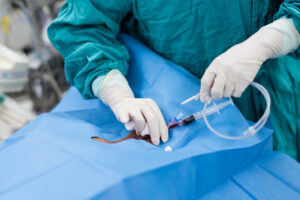Infection preventionists were monitoring for rising cases of HAIs amid the pandemic.

While the U.S. healthcare system has been so focused on combatting COVID-19, infection preventionists have been worried of a rise in cases of other infectious diseases or hospital-acquired infections.
“We are still looking at the data, but the most concerning is bloodstream infections,” said Linda Dickey, RN, MPH, CIC, FAPIC, Dickey Consulting LLC and president-elect of the Association for Professionals in Infection Control and Prevention (APIC). “It’s too early to know what the correlation might be specifically related to COVID care. Initially in the pandemic we saw a real drop in the volume of patients because they were afraid to come in for care, and you can blame that on COVID. But it does nobody any good if they need emergency care and they are scared to come in.”
In fact, according to a recent study published in Infection Control & Hospital Epidemiology, HAIs in hospitals may have increased after several years of declining cases.
From 2015 to 2019, there was a sizable decline (31%) in the national standardized infection ratio (SIR) for central-line–associated bloodstream infections (CLABSIs). To understand the impact of the early months of the COVID-19 pandemic on central-line–associated bloodstream infections (CLABSIs) nationally, Prachi R. Patel, M.P.H., from the U.S. Centers for Disease Control and Prevention, and industry colleagues studied SIRs for the second quarter of 2020 (2020 Q2: April, May, June) were compared to those from 2019 Q2.
From the analysis, which included 13,136 inpatient units from 2,986 acute-care hospitals, a 28% increase was observed in the national SIR, from 0.68 in 2019 Q2 to 0.87 in 2020 Q2.
Critical care units had the greatest percentage increase (39%) in SIR, while ward locations experienced the second highest increase (13%). Critical care locations had the highest number of CLABSIs in 2020 Q2, with 1,911 events. Hospitals in all bed-size categories exhibited an increase in SIR, according to the authors.
“Infection control practices changed in many healthcare settings during the pandemic to accommodate increasing numbers of patients and to mitigate shortages of personal protective equipment, supplies, and staffing,” the study authors wrote. “Reducing the frequency of contacts with patients and of maintenance activities for central venous catheters (eg, chlorhexidine bathing, scrubbing the hub, site examinations) as well as alterations to processes of care (eg, risking disrupting catheter dressings when placing patients in a prone position) all have the potential to contribute to an increase in CLABSIs.”
For more on the study, visit: www.cambridge.org/core/journals/infection-control-and-hospital-epidemiology/article/impact-of-covid19-pandemic-on-central-lineassociated-bloodstream-infections-during-the-early-months-of-2020-national-healthcare-safety-network/F4FBF17FE70FED931B54097A2AC400C9.
